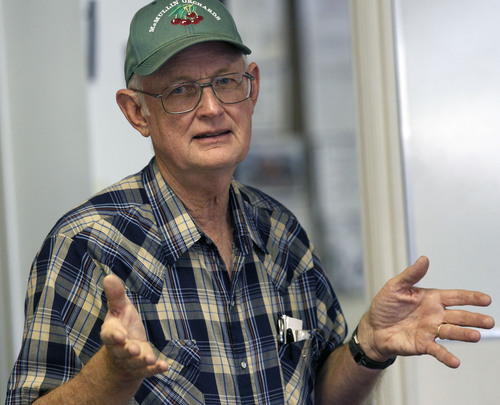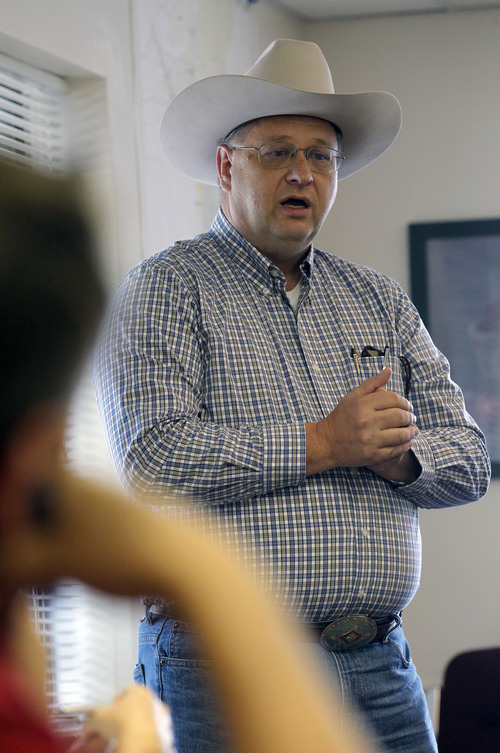This is an archived article that was published on sltrib.com in 2013, and information in the article may be outdated. It is provided only for personal research purposes and may not be reprinted.
Payson • Fruit farmer Robert McMullin does not worry that too many immigrants are flooding the country. He worries there are too few and says he and other Utah farmers need more immigrants to do the hard, lower-paying farm work that resident Americans refuse to take on.
"This year with our sweet cherry crop, we had to leave fruit in the field because we couldn't get enough people to harvest it. It just got to be too old," he said. "I get concerned about that same thing happening now with our peaches and apples."
Unusually hot weather combined with cool nights now mean "the peaches will ripen up overnight, so we need lots of hands to get those peaches picked. We just don't have enough help to do that," McMullin said. "We need another four or five guys to help us." But seven workers just returned to Mexico because their time was up on H-2A farm worker visas, and they could not get extensions.
McMullin was among several farmers and ranchers who spoke in a tour Friday organized by the Utah Farm Bureau to send the message that immigration reform should help Utah obtain more foreign farm workers, and fix problems with the current temporary worker programs.
"Without them [immigrant workers], we would all go out of business," said Santaquin fruit farmer Curtis Rowley, who — like others on the tour — say he uses immigrants who are here legally. But the process to get them here is expensive and difficult, and often does not bring in all the people needed.
—
Unwanted jobs • Farmers say these foreign workers are not costing Utahns jobs, but doing work that virtually no one here wants.
"Say what you want to say, it's beneath them [Americans]. It's just one of those jobs people don't want to do," said Brad Bateman about milking and caring for dairy cows. His family dairy west of Utah Lake milks 6,800 cows three times daily. It is an around-the-clock operation that employs 90 people. The herd is so large that an average of 28 calves are born every day.
Farmers and ranchers say they have proof that other Americans don't want such jobs.
Rowley said that to be able to bring in foreign workers from abroad, the government requires him to first advertise his jobs in four states for several months. He must give the jobs to any Americans who want them, and provide the same free transportation and housing that he would be required to give foreign workers.
He says he's had a few teenagers and some older people apply occasionally.
But if they try it for a few hours, "they never show up again," he said. Even if they did, they work far slower and less effectively than trained foreign workers he brings in at the same price.
McMullin says his experience is the same. "I think the record we have had is one guy worked all day once," he said. "Usually it's one or two hours."
Larry Williams, an attorney for the Western Range Association of sheep ranchers, said his organization has only found one resident American willing to take one of the sheepherder jobs it advertises. They pay only $750 a month in Utah, plus room and board — a pay level set by the federal government through the H-2A program.
He said his group normally must go to Peru now to find people willing to take the jobs. "We are always looking for a few more."
—
Not cheap • Bateman, the dairy farmer, said, "It's not about cheap labor. It's about labor, period. It's about getting the workforce we need."
Rowley said his H-2A workers are paid $10.05 an hour, set by the H-2A program, plus housing and transportation from their native countries. He figures it costs him — counting housing, transportation and legal work — about $15 an hour per person for the crew he maintains from January through October. For extra harvest help, he said it costs $22 to $24 per hour.
"It's expensive," Rowley said, adding he has no option. On the bright side, he says the H-2A program allows him to bring in the same people year after year, and they become well-trained and effective — so he says he is able to accomplish the needed work with fewer people in recent years.
Bateman said the H-2A program is designed for temporary, seasonal work, and is not an option for him because his dairy jobs are neither. About 75 percent of his workers are Latino immigrants who made their way into the country legally by other means and programs, he said, and it is tough to find enough to do the work needed even though he says he pays "above minimum wage."
Farmers and ranchers say they would like to see a variety of changes in the H-2A and similar programs. For example, Bateman said dairies need temporary worker programs to allow people to stay longer.
Williams said some exemptions already do that for sheepherders, allowing them to stay for up to three years.
McMullin said he would like to see more flexibility. Now H-2A workers can work for only one employer, doing one type of work — but he would like the possibility to maybe share workers with nearby dairies or flower-growing operations. "We'd like to be able to use them not only out in the field, but also in the processing plant," he said.
Rowley said the H-2A program would be more affordable for farmers if workers paid their own way from their home countries. He suggests allowing that, and also allowing them to work wherever they choose. "They will go to the places that offer the best housing. I think that would help us," he said.
Rowley said he now must plan up to a year in advance to jump through all the legal, advertising and other regulatory hoops to get people to his farm when he needs them.
"It could be a lot easier," he said.





